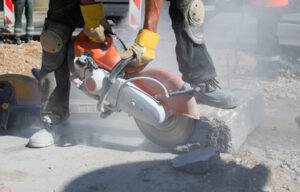Concrete Repair Bismarck techniques can vary greatly depending on the type of damage and its severity. It can range from simple patching to tearing out the old and replacing it with new concrete.

Cracks and spalling are a sure sign of structural issues that need to be addressed immediately. These issues include chemical overexposure, steel reinforcement too close to the surface and improper aggregates.
Whether they’re in driveways, garage floors or sidewalks, cracks in concrete can be serious problems. They can expose underlying structural issues and create safety hazards for pedestrians, vehicles or machinery. They can also deteriorate concrete faster, leading to costly replacement and maintenance costs. It’s important to determine the cause of cracking before attempting repairs, and to use the right repair products for the job.
Cracks aren’t always a bad thing and can be repaired with concrete caulk or self-leveling concrete crack filler. However, a crack that widens or is part of a larger network may need to be professionally assessed and repaired by a contractor.
Before applying any crack filler, it’s important to clean the area around it with a pressure washer or detergent to remove any dirt or debris. This will ensure a clean surface for the crack filler to adhere to and a more durable result.
Concrete cracks can be caused by a variety of things, including poor construction practices, ground movement or environmental factors. To prevent new concrete from cracking, it’s essential that it’s poured properly and that control joints are placed at the appropriate intervals. Additionally, regular application of a concrete sealer can help to protect the slab from moisture damage and extend the life of the concrete.
Once the cracks in concrete have been filled, it’s important to allow the filler to dry completely before returning the structure to service. The curing process varies between products, so be sure to follow the instructions carefully.
For long-lasting, high-performance crack repair, professional contractors rely on polyurethane resins, foams and epoxies. These products offer the flexibility to address a range of issues, from surface cracks to deep structural fissures. With a wide range of applications, these repair solutions are an integral tool in the arsenal of professionals committed to maintaining the integrity of concrete structures. They can be used to seal cracks, prevent moisture ingress and provide strength re-injection for damaged concrete. They’re also able to tackle re-entrant corners and other areas where stress concentrations can lead to cracking. When these high-strength solutions are used in conjunction with other repair methods, they can ensure a safe, effective and long-lasting solution.
Leaks
Leaks in concrete slabs are a common problem that can cause significant damage to your home. It can result in water damage, mold growth, and other issues that affect your home’s value and the comfort of living there. While it’s not a good idea to ignore these problems, there are ways to get them fixed. One of the best ways to find leaks in your concrete slab is by looking for damp spots or puddles that don’t disappear. Moisture stains and the smell of mildew could also be a sign that there is a leak in your concrete slab. If you’re worried about a potential leak in your slab, you should contact a professional who can use sensitive equipment to locate it. They will use methods like acoustic detection to listen for the sound of running water underneath your floors. Once they have pinpointed the location of the leak, they can fix it with trenchless pipe repair techniques.
When repairing cracks in concrete, the most important thing is to seal them properly. To do this, it’s best to use a hydraulic cement, such as Kryton’s Krystol Plug. This product is a liquid concrete that expands as it dries, filling in cracks and crevices in your concrete. It also provides a barrier against future leaks.
Before you can apply a hydraulic cement to your concrete, it’s important that it is clean and free of any dust or sandblasting residue. You should also blow the cracks with compressed air to remove any dirt or debris that could prevent the cement from bonding to the concrete.
It’s also essential that you prepare the crack before you can inject it with epoxy or other materials. This means chiseling away the sides of the crack with an electric chipping hammer and creating a chase, which is a narrow opening that you can use to insert your leak sealing material. This can be done with a concrete chisel, but it’s a better idea to use a special tool that is specifically designed for this purpose.
Once you’ve created your chase, it’s time to add the injection product. There are many different products available on the market, but the optimum choice depends on your leak’s location and severity. For example, a slab leak in the hot or cold lines usually doesn’t require a full replacement of the pipes; it can simply be repaired with an epoxy lining. However, a leak in the main line may require extensive pipe splitting and new installation.
Moisture
Moisture is both a friend and an enemy to concrete. Its presence affects many aspects of a concrete structure, from the initial curing process to long-term durability. However, moisture-related problems can often be corrected with a comprehensive approach that includes the use of quality materials, adherence to best practices in mixing and curing, and proper surface preparation. Regular inspections are also essential to identify and address moisture issues early.
Moisture levels that go unaddressed can contribute to a number of problems, including cracking, spalling and corrosion of steel reinforcement. These issues can be caused by condensation, freeze-thaw cycles, excessive vapor transmission and poor drainage.
The most common cause of moisture damage is inadequate concrete surface preparation, resulting in a wet or soft slab. To avoid this problem, it is essential to thoroughly clean the concrete surface of all dirt and dust, then pressure wash to remove any remaining dirt or debris. It is also important to ensure that the concrete is adequately consolidated, especially around dowel bars and along the patch perimeter. Failure to do so can result in honeycombing, which significantly reduces the strength and durability of a concrete repair.
To control moisture during the repair process, it is important to monitor the moisture content of the concrete surface using a moisture meter. This device will indicate the level of moisture present in the concrete, which can help you determine if the moisture is coming from an internal source or external source. If the source is internal, it may be due to a correctable condition such as improper site drainage or groundwater seepage.
If an internal source of moisture is identified, it can be addressed by applying a bonding agent to the surface of the concrete before resurfacing. This product will improve the adhesion of the new material to the old concrete and help prevent future cracking. Another option is to use a concrete patching compound, which can be applied to the affected area with a putty knife or trowel and can be shaped and smoothed with a drywall tool.
Structural Damage
Concrete is a durable material that can be used in a wide range of applications. But like all materials, concrete will degrade over time and needs to be repaired or replaced if it is to continue serving its intended function. Many issues can cause damage to concrete, including chemical exposure, moisture infiltration and environmental stressors. The best way to address these issues is through proactive maintenance, catching damage early and addressing it immediately before it worsens.
The first step in repairing concrete is to thoroughly clean the damaged surface using a pressure washer or hose. This removes dirt and debris and creates a good surface for the new repair material to adhere to. Concrete repair materials are available in a wide range of types, from quick-setting concrete to patching compounds, and there are even eco-friendly options to consider. It is important to choose a product that is suitable for your project and follow the manufacturer’s instructions for application.
Next, you will want to identify the type of concrete damage that you need to repair. Cracks and spalling are a clear sign of needing structural repair, and they can indicate that there is an issue with chemical overexposure, steel reinforcement that is too close to the surface or there is underlying rust, excessive moisture or poor quality concrete. Hairline cracks can be caused by settling or changes in the environment and are typically short in length.
Chemical deterioration of concrete is caused by chlorides and sulfates, which penetrate the surface and corrode embedded steel reinforcement. This corrosion weakens the concrete, and it is often accompanied by cracking. To fix this, you will need to remove the corroded steel and treat it, which will help prevent further damage. Other structural issues can include floor or wall movement, displaced joints and extensive undermining of the concrete. These issues are typically more serious and require a professional engineer to assess and recommend repairs.
